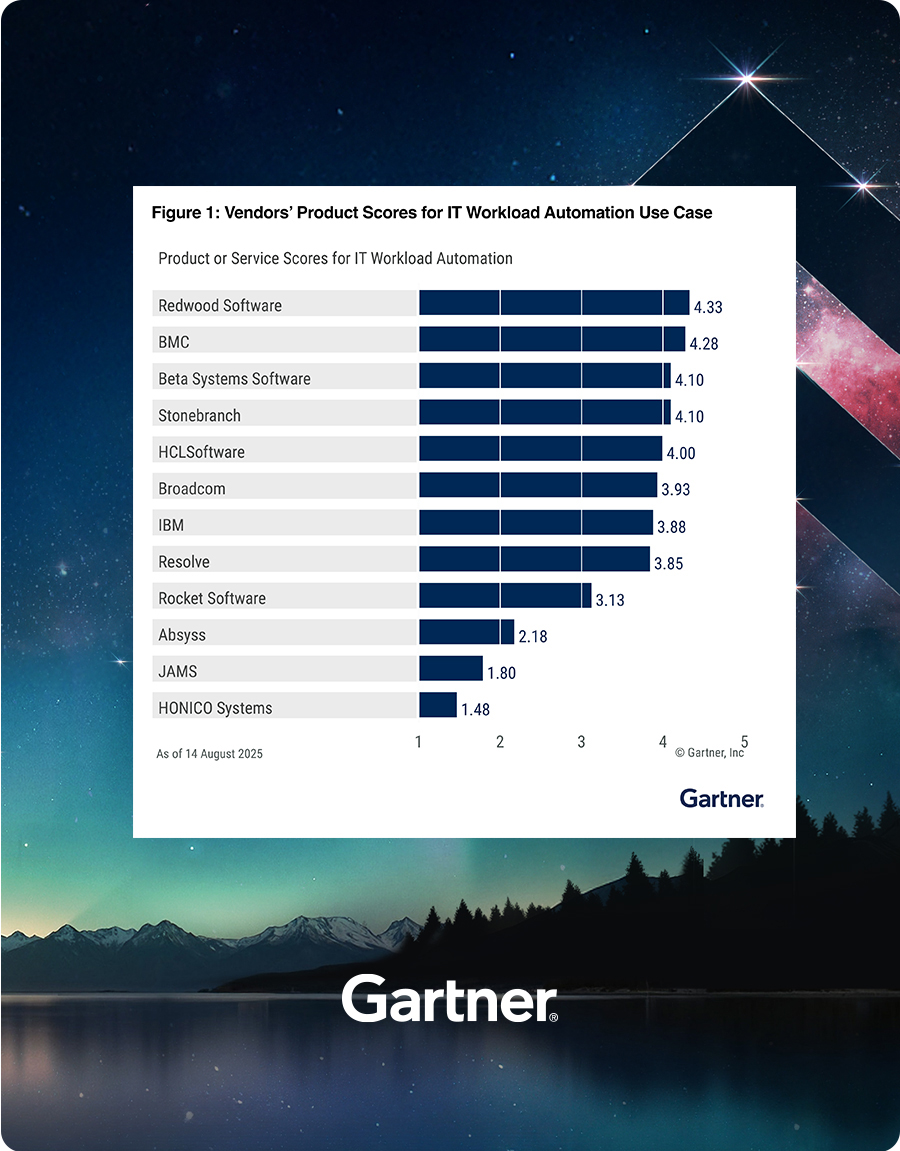Gartner® Critical Capabilities for Service Orchestration and Automation Platforms
Learn why Redwood Software scored highest in five out of five Use Cases: IT Workload Automation, IT Workflow Orchestration, Data Orchestration, Citizen Automation and DevOps Automation.

A companion analysis to Gartner Magic Quadrant™ for SOAPs
In the 2025 Gartner Magic Quadrant™ for SOAP report, Redwood was named a Leader, positioned furthest in Completeness of Vision and highest for Ability to Execute.
In the companion Critical Capabilities for SOAP report, we believe Gartner supports the investment decision-making process, expanding upon the evaluation of SOAPs with a detailed explanation of five primary Use Cases. Redwood ranked #1 in five out of five Use Cases, receiving a score of 4.33 out of 5 for IT Workload Automation, 4.43 out of 5 for IT Workflow Orchestration, 4.43 out of 5 for Data Orchestration, 4.45 out of 5 for Citizen Automation and 4.35 out of 5 for DevOps Automation.
We believe Redwood’s scores in these Use Cases reflect our strengths in delivering powerful automation fabrics solutions to address a wide variety of business needs and functions. Redwood solutions provide end-to-end orchestration for complex workflows that span critical business systems, including ERP applications, driving unmatched process optimization. Redwood empowers organizations to standardize and simplify IT and business processes, gain deep observability into every automated workflow, scale with unmatched reliability and align automation with broader strategic planning goals. Customers accelerate digital transformation and unleash human potential.
Get the 2025 Gartner Critical Capabilities for SOAPs report
In this report, Gartner “provides deeper insight into providers’ product and service offerings by extending the Magic Quadrant™ analysis.”* Read the full analyst report to find out why Redwood was ranked first in five Use Cases and choose the right solution to support your automation strategy, digital infrastructure and IT operations roadmap.
Gartner Critical Capabilities FAQs
What is the Gartner Critical Capabilities report?
“A Critical Capabilities document is a comparative analysis that scores competing products or services against a set of critical differentiators identified by Gartner. It shows you which products or services are a best fit in various use cases to provide you actionable advice on which products/services you should add to your vendor shortlists for further evaluation.”
What’s the difference between Critical Capabilities and Magic Quadrant?
“Critical Capabilities research complements a Gartner Magic Quadrant™ by allowing deeper insight into the providers’ product or service offerings by identifying which ones best fit various use cases. Magic Quadrants™ position vendors in a market, while Critical Capabilities provides a deeper dive into the providers’ product and service offerings. Magic Quadrants™ contain a broader analysis of the vendors in a market, while the companion Critical Capabilities directly focuses on the product/service offering. As companion research notes, they offer a market and product/service view that provides powerful insight when making technology decisions.”
Gartner, Inc. Magic Quadrant for Service Orchestration and Automation Platforms. Hassan Ennaciri, Daniel Betts, Cameron Haight, Chris Saunderson, etl. 26 Aug 2025.
Gartner, Critical Capabilities for Service Orchestration and Automation Platforms, Chris Saunderson, Cameron Haight, Daniel Betts, Hassan Ennaciri, etl. 26 Aug 2025.
GARTNER is a registered trademark and service mark of Gartner, Inc. and/or its affiliates in the U.S. and internationally, and MAGIC QUADRANT is a registered trademark of Gartner, Inc. and/or its affiliates and are used herein with permission. All rights reserved.
Gartner does not endorse any vendor, product or service depicted in its research publications, and does not advise technology users to select only those vendors with the highest ratings or other designation. Gartner research publications consist of the opinions of Gartner’s research organization and should not be construed as statements of fact. Gartner disclaims all warranties, expressed or implied, with respect to this research, including any warranties of merchantability or fitness for a particular purpose.